
Today we have the award winning game developer, Ty Taylor, joining us for a question and answer session. Ty is a renowned game designer and developer that leads the Seattle based indie studio, The Quantum Astrophysicists Guild.
His first major game, The Bridge, received critical acclaim and many awards. The Bridge is a 2D puzzle game that requires players to use movement of both their character and of gravity to solve puzzle levels in an M.C. Escher inspired world. More recently, Ty has been developing the game Tumblestone, another puzzle based game that has surprisingly addicting competitive modes. It, too, has been sweeping up the awards, and it will be released later this year.
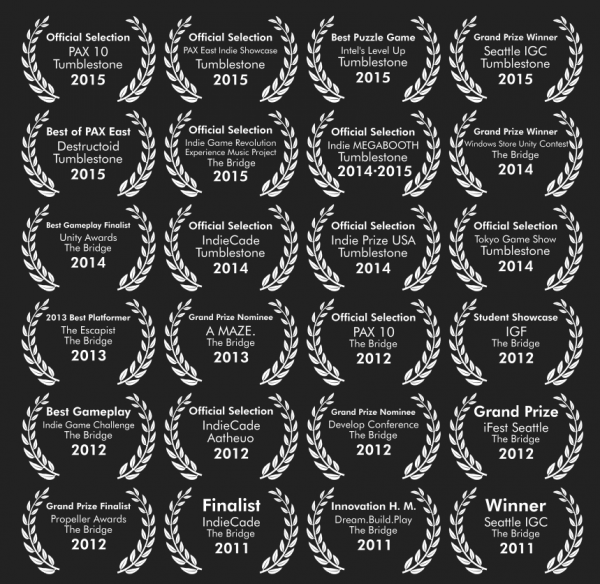
So, you have a new game launching June 2016, Tumblestone, could you tell me a bit about it?
I think of Tumblestone as a complete reinvention of the “Match-3” genre. I actually started designing the game as a core logical puzzle game, but it was only somewhat by accident also Match-3. The way it works is that you’re given a 5-column board full of colored blocks, and the goal is to clear the board by only removing blocks from the bottom, three-at-a-time. It sounds like a simple and straight-forward concept, but there is an incredible amount of depth with the planning involved, as if you choose the wrong order, you’ll leave yourself in an unsolvable state.
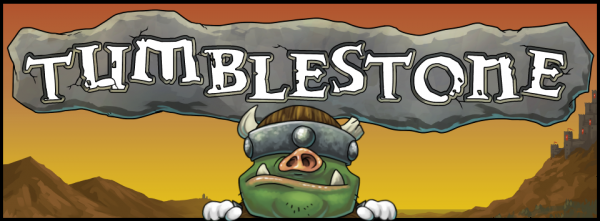
When playing Tumblestone myself, I became quickly aware of how easy it is to make it unsolvable! What game modes are planned for launch?
There’s a somewhat enormous (30+ hour) story mode, which is a series of 360 puzzles. All of those puzzles are either hand-designed or curated, without a time constraint, and meant to be particularly challenging. We also divide the story mode into 12 worlds, where each of those worlds has it’s own gameplay modifier (wildcards, blocker pieces, etc.) to keep the gameplay spicy and interesting. Outside of the story mode, there are three single-player arcade modes, which randomly generate the game boards as you play, and the idea is that you try to play as long as you can to get a high score (we have online leaderboards for these). The Heartbeat Arcade mode is based around speed and quick wits, the Marathon Arcade mode doesn’t have a timer and focuses heavily around not making mistakes, and the Infinipuzzle Arcade mode is about solving as many consecutive puzzles as you can without making a mistake. And finally, there’s the multiplayer, which if you’ve played Tumblestone at gaming expos, tends to be the highlight of those shows. These modes task you with racing your opponents to solve a puzzle first, and with everyone having the same game board, it often comes down to the last couple of blocks. It can get incredibly heated and intense when just as you think you’ve solved it, someone beats you to the last block.
Sounds like there’s a mode for everyone who enjoys puzzles. Competitive puzzle solving, especially based on solution speed, is not a common multiplayer approach; what gave you the idea?
I definitely wanted Tumblestone to be a game for everyone, which is why there is so much breadth in the game modes. Whether you’re a super casual gamer or hardcore competitive gamer, Tumblestone will have something for you. I was pretty unsure at first if mixing cerebral, logical puzzles with a time-based component was a good idea. I’ve been designing puzzles for years, and before Tumblestone I had a pretty deeply-held believe that players shouldn’t be under time constraints when solving puzzles. The Achievement in Braid where you had to complete the full game in 45 minutes really annoyed me, because I felt that it took away from the purity of puzzle solving. With Tumblestone, our first crack at multiplayer wasn’t actually about solving a puzzle fastest, it was more along the lines of making triplets fastest, and making a mistake didn’t have nearly as much of a negative impact (our first game mode was basically multiplayer Heartbeat). You sent blocks to your opponents and speed mattered much more than wits. It was fun enough, but I think the invention that really elevated Tumblestone to whole new level was the “Puzzle Race” multiplayer mode, which at first I was convinced would never work (because of my beliefs about puzzle purity and no time constraints). But after playtesting the mode, and seeing the raw excitement and adrenaline that people experienced in the final miliseconds of a round, I realized that we had a golden concept.
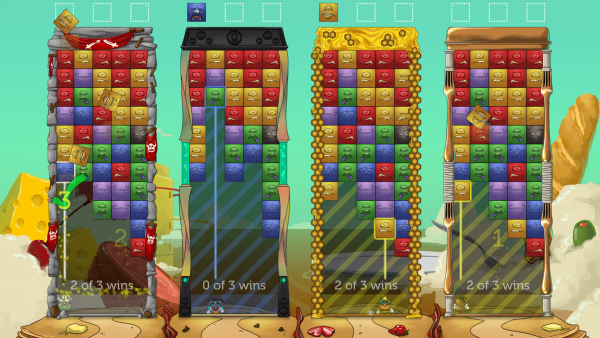
Adrenaline and excitement are two great words to describe how people react to Tumblestone‘s multiplayer mode. How does it make you feel to witness people reacting so passionately to a game you’ve created?
It’s an amazing experience. I feel like a rockstar every time I go to an expo and see a group of people playing Tumblestone. They’re always timid at first, not having seen or heard of the game before, and sometimes not thinking the game is for them. “I don’t really play matching games,” they might say. After a little persuasion, they’ll start playing, then start laughing, then start screaming, and then finally we’ll have to pry them away from the controller because there’s another group of people waiting to play. And it’s always incredibly humbling and flattering when people come back later with friends or tell me that Tumblestone was their favorite game of the show.
That’s great to hear. Another thing that makes Tumblestone unique is your number of planned launch platforms, could you tell me about that?
Tumblestone‘s multiplatform release is pretty ambitious. Actually, “ambitious” might be an understatement, most other developers I talk to call me insane. Including different Windows and Android distributors, Tumblestone is launching to over 25 platforms at the exact same time. Everything from Steam on Windows, Mac, and Linux, to Xbox 360 and Xbox One, PS3, 4, Vita, Wii U, iPhone/iPad, Android phones/tablets, Windows Store and Windows Phone, Facebook, Android TV, FireTV… everything! Unity helps considerably, but aside from the technical advantages it provides, there is still a considerable amount of work: formatting for touch, keyboard, and controller, making the game look good in both portrait and landscape, optimizing to the point it runs at 60 FPS on a PS Vita or cheap Android device, not to mention all of the publishing work that we’re doing ourselves. Right now we’re about a month away from having a totally finished game on Windows, but we’re going to sit on that for 5 or 6 months until we finish all of the other platforms. The 5 or 6 months could easy be over a year had I not gone through all of this before with The Bridge. This is just the first time I’m doing it all simultaneously, so it’ll be an interesting challenge coordinating everything.
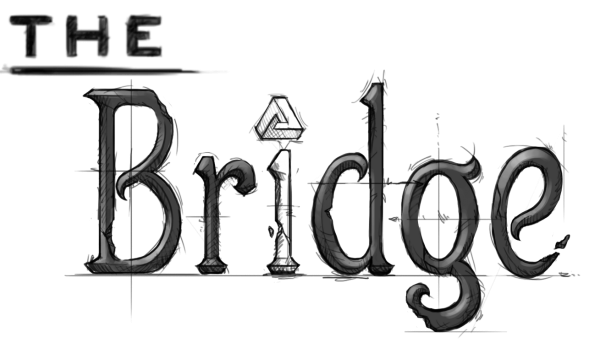
It’s great that you’ve mentioned The Bridge. It’s your previous title that was very successful. Aside from teaching you about launching on various preforms, what did you learn from the development of The Bridge?
It’s difficult to articulate exactly what I learned from The Bridge. I worked on that game for over three years, and throughout the development I learned literally thousands of minor, subtle things which individually don’t seem like much, but combined gave me a huge amount of experience that has helped make me the developer I am today. I hit dozens of roadblocks and hurdles with The Bridge that have made me a better engineer, designer, and producer having overcome them. And now, all of these issues I know upfront for Tumblestone‘s development, and this has created a smoother and faster development process, in addition to simply enabling me to design a better game from the beginning.
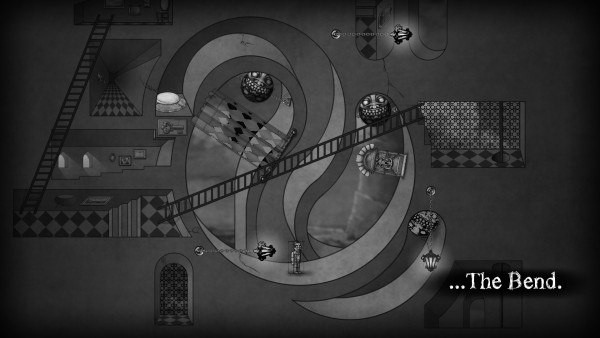
Do you have any advice for aspiring game developers?
Make as many games as you can. Start small. Make games on the scale of Pong at first…something incredibly simple that you can complete. Do game jams. Make as many small projects or prototypes as you can, getting gradually more complex. It’s easy to have a grandiose idea, but actually implementing a large-scale game is incredibly difficult, even for a large team of experienced people. If you want to stand out, make a simple game with a unique or novel concept. Be able to evaluate your prototypes honestly and fail early.
Where do you draw your inspirations from? Is there anyone that inspires you?
I think games inspire me more than the people who create them. While I might admire or respect someone because of their projects or working methods, ultimately it’s their final product that I tend to be inspired from. And it varies by game I’m working on. With The Bridge, I was heavily inspired by games like Braid and Portal (and, of course, the artwork of M. C. Escher). With Tumblestone, I’m inspired by games like Towerfall and Tetris Attack. Also, I’m not sure if “inspired” is the right word here, but I really pick up on when a game I play does something wrong. I won’t name any names of course, but when I play a game with some painfully obvious flaw, it really tends to nag at me, so I definitely keep that flaw in my mind when I’m designing a game to make sure I don’t do the same thing.
Do you have any plans for what you will do after Tumblestone launches?
I’ve got this Google Doc that I keep as a bookmark on my Chrome toolbar. It’s a list of every game idea I’ve ever had. Whenever I’m not working on developing a game, or when my mind isn’t otherwise preoccupied with something else, I’m inventing little games in my head. Just little kernels of ideas that I get staring at patterns or inspired by events in my life. Whenever I have an idea I’ll write it down, no matter what it is…just a few sentences or a paragraph – just enough for me to remember it later if I want to come back to it and prototype it. At this point I’ve added well over 100 unique games that I could prototype when I have the free time. It’s a somewhat poetic tragedy that I’m going to die before I get a chance to create all of the games that I’d like to make.
Perhaps we’ll unlock the secrets of immortality in your lifetime and you will get to make all of those games, though it sounds like you will still keep coming up with them faster than you can make them.
Exactly! Since starting Tumblestone I’ve added at least 50.
Impressive! Well, thank you for your time. Any parting words for our readers?
Thanks for having me. Happy New Year, and keep an eye out for Tumblestone this summer!
